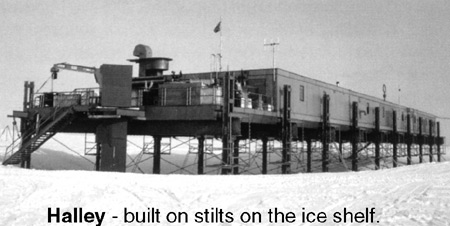
| Glasgow Digital Library | Voyage of the Scotia | BRUCE | PEOPLE | SHIP | ANTARCTIC | INDEX |
|---|
Ozone is found naturally in the atmosphere, created by several complex reactions between ultraviolet radiation and oxygen. Until 25 years ago ozone was perfectly in balance in the atmosphere, but it is now at a very low level. Ozone helps to protect the Earth's surface from ultraviolet radiation.
Ozone has been measured by the BAS for over 40 years using a Dobson spectrophotometer. Measurements began at the BAS Halley base in 1957, but it was the early 1980s when the scientists found alarming changes.
During the month of October each year it was found the ozone layer over the Antarctic was almost completely destroyed - in other words the survey team had discovered a hole in the ozone layer.
The decline of the ozone content in the atmosphere has continued, and by 1998 around 40% of the ozone had been lost between 14km (nine miles) and 22km (13 miles) above the Earth's surface for a period of six weeks. In the spring and summer months in the Antarctic the hole is about the size of Western Europe. It is much smaller in the winter.

Chlorofluorocarbons (CFCs) were found to be the main agent of ozone destruction. CFCs are used in fridges, air conditioning, plastic foams and aerosol sprays, and can remain in the atmosphere for over 100 years. CFCs are broken down by ultraviolet radiation and turned into chlorine which acts as a catalyst in ozone destruction.
In 1989, many countries got together and agreed to ban CFCs. CFCs are no longer produced in Europe although destruction of old refrigerators can still release these gases. It is hoped that by 2010 all CFC production will have ceased.
CFCs can also act as greenhouse gases.
| Glasgow Digital Library | Voyage of the Scotia | BRUCE | PEOPLE | SHIP | ANTARCTIC | INDEX |
|---|